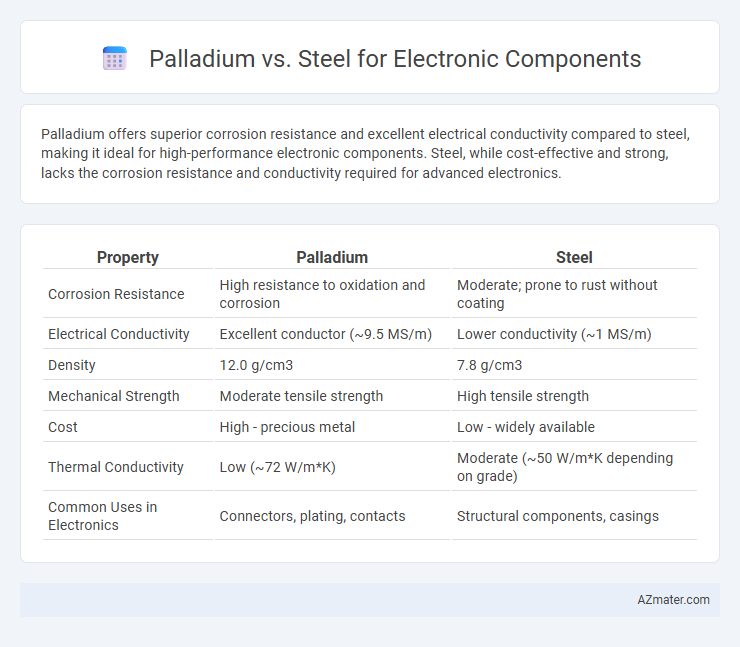Palladium offers superior corrosion resistance and excellent electrical conductivity compared to steel, making it ideal for high-performance electronic components. Steel, while cost-effective and strong, lacks the corrosion resistance and conductivity required for advanced electronics.
Table of Comparison
| Property | Palladium | Steel |
|---|---|---|
| Corrosion Resistance | High resistance to oxidation and corrosion | Moderate; prone to rust without coating |
| Electrical Conductivity | Excellent conductor (~9.5 MS/m) | Lower conductivity (~1 MS/m) |
| Density | 12.0 g/cm3 | 7.8 g/cm3 |
| Mechanical Strength | Moderate tensile strength | High tensile strength |
| Cost | High - precious metal | Low - widely available |
| Thermal Conductivity | Low (~72 W/m*K) | Moderate (~50 W/m*K depending on grade) |
| Common Uses in Electronics | Connectors, plating, contacts | Structural components, casings |
Introduction to Palladium and Steel in Electronics
Palladium, a precious metal known for its excellent corrosion resistance and superior electrical conductivity, is widely used in electronic components such as connectors, capacitors, and circuit boards to ensure reliable performance and longevity. Steel, typically stainless, offers mechanical strength and durability in electronic applications, acting as chassis material and structural support while often requiring additional coatings to enhance conductivity and prevent corrosion. The choice between palladium and steel in electronics balances the need for electrical efficiency and material robustness, with palladium favored for precision conductive elements and steel preferred for mechanical stability.
Material Properties Comparison: Palladium vs Steel
Palladium exhibits excellent corrosion resistance and electrical conductivity, making it ideal for electronic component contacts and connectors, while steel offers superior mechanical strength and durability but lacks comparable conductivity. The high melting point of palladium (1555degC) supports stability under thermal stress, whereas steel's melting range varies around 1370-1510degC depending on alloy composition. Palladium's ductility enables fine wire applications in electronics, contrasting with steel's rigidity that suits structural supports rather than sensitive electronic interfaces.
Conductivity Differences in Electronic Applications
Palladium exhibits superior electrical conductivity compared to most types of steel, making it a preferred choice for critical electronic components requiring efficient current flow. While steel offers durability and cost-effectiveness, its lower conductivity limits performance in high-frequency or sensitive electronic circuits. Palladium's resistance to oxidation and stable conductivity under varying temperatures further enhance its value in precision electronic applications.
Corrosion Resistance: Palladium vs Steel
Palladium exhibits superior corrosion resistance compared to steel, making it a preferred material for electronic components exposed to harsh environments. Unlike steel, which is prone to rust and oxidation due to its iron content, palladium maintains its integrity and conductivity without forming oxide layers. This resistance to corrosion ensures enhanced longevity and reliability in critical electronic applications where exposure to moisture and chemicals is common.
Cost Analysis: Palladium and Steel Components
Palladium components in electronics offer superior corrosion resistance and conductivity but come at a significantly higher cost compared to steel, making them less economical for mass production. Steel components are favored for their affordability and mechanical strength, although they may require additional coatings to enhance durability and conductivity. Cost analysis typically shows steel as the budget-friendly choice for most electronic applications, whereas palladium is reserved for high-performance or specialized uses where cost is less critical.
Durability and Longevity in Electronic Devices
Palladium offers superior corrosion resistance and excellent electrical conductivity, enhancing the durability and longevity of electronic components compared to steel. Steel, while strong and cost-effective, is prone to oxidation and can degrade performance over time in high-moisture or corrosive environments. The use of palladium in connectors and contacts significantly reduces failure rates and extends device lifespan, making it the preferred material for critical electronic applications.
Manufacturing Processes and Compatibility
Palladium offers superior corrosion resistance and excellent solderability, making it highly compatible with complex electronic components and advanced manufacturing processes like thin-film deposition and plating. Steel, while more cost-effective and mechanically robust, requires additional surface treatments such as plating or coating to enhance electrical conductivity and corrosion resistance for electronic applications. The choice between palladium and steel largely depends on the specific manufacturing processes involved and the desired electrical performance and reliability of the final electronic component.
Environmental Impact and Sustainability
Palladium, a rare precious metal used in electronic components, offers superior corrosion resistance and conductivity but involves environmentally intensive mining processes with significant habitat disruption and carbon emissions. Steel, predominantly recycled in electronics manufacturing, provides a more sustainable option through established recycling infrastructure that reduces raw material extraction and energy consumption. Choosing steel over palladium supports lower environmental impact and enhances sustainability in electronic component production.
Industry Preferences and Use Cases
Palladium is favored in electronic components for its excellent corrosion resistance and superior electrical conductivity, making it ideal for high-reliability applications like connectors and multilayer ceramic capacitors. Steel, while less conductive, is chosen for structural parts and electromagnetic shielding due to its strength and cost-effectiveness in consumer electronics and automotive industries. Industry preferences hinge on performance demands and budget constraints, with palladium prevailing in precision and high-frequency devices, whereas steel suits mass-produced or mechanically intensive components.
Choosing the Right Material for Electronic Components
Palladium offers exceptional corrosion resistance and excellent electrical conductivity, making it ideal for high-reliability electronic components exposed to harsh environments. Steel provides superior mechanical strength and cost efficiency but may require surface treatments to prevent oxidation and maintain conductivity in electronic applications. Selecting between palladium and steel depends on balancing performance requirements, environmental conditions, and budget constraints to ensure optimal component longevity and functionality.

Infographic: Palladium vs Steel for Electronic Component
 azmater.com
azmater.com